
South African hikes
The scourge of Wessel!
Exploring Oorlogskloof Nature Reserve
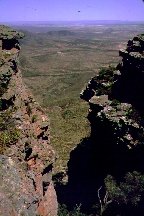
 |
South African hikes The scourge of Wessel! Exploring Oorlogskloof Nature Reserve |
 |
|
|
| Remember the times as a small kid
when you would find some disused quarry where you would play and act out those child-like
fantasy battles with your school buddies. Well, imagine a place where this might be
possible on a macro scale and Oorlogskloof would be it! "Oorlog" is the
Afrikaans for war, "kloof" being a gorge. It is a wilderness of gorges, caves,
rivers, plateaux, with an abundance of natural flora and fauna, the former sufficient in
driving a botanist delirious, while providing a stern challenge to any serious
hiker/adventurer. Truly a paradise! Situated in the Northern Cape, South Africa, near
Nieuwoudtville, on the R27 en route to Calvinia and just over Van Rhyns Pass off the N7,
Oorlogskloof is steeped in history. This is where the cruelty of war was played out in
reality in 1739, in skirmishes between the indigenous Khoi and farmers after disputes
arose (see inset).
Feeling adventurous, three of us decided to check out the area, contacting Cape Nature Conservation in the process. Day routes or circular hikes longer than one day are on offer. We opted for the "Kransduifroete" or Rock Pigeon route rather than the "Geelbekbosduifroete" or Rameron Pigeon route. Though both routes are of the order of 52 km, the comfort of tents and mattresses provided on the former route proved to be the mitigating factor. A quick detour was required to pick up the permits in Nieuwoudtville and find out a bit more about the hike itself at their good offices. A well-mannered official in khaki uniform known as Wessel obliged and gave us the details. He wished us well, though his thinly disguised wry smile did not go unnoticed. After returning to the turn-off, we accessed a dozen or more farm gate en route to the car park, where our vehicle would remain for the next 5 days. Several others had arrived ahead of us, though the quick exhaust-pipe test indicated that they had probably been there for some time. Darn it, that meant that the team of Swedish volleyball players, female naturally, that we'd been hoping for, were at least a day ahead of us! |
| Day one: Groot Tuin - Brakwater (4km) |
| The brochures advised us to cover the initial 4 km stretch of the first day and not couple it to day two's distance. A wonderfully expressive Afrikaans colloquialism to the effect that Wessel does not distort the truth, sprung to mind. This took us on a meandering route over, under and around huge boulders, sometimes with the use of ladders or ropes, providing us with a sample of what we presumed Wessel had in store for us. The precedent was well and truly set. We realised that every detour, every non-obvious path for the next few days was to be a well-planned Wessel ploy to show us a cave, a chimney, a view, a rare plant (the latter would be lost on us unfortunately). The approach to the campsite involved a descent into the sumptuous valley below. Ralph surmised that Wessel must have been in the army at some stage, because his approaches to a camp followed the prescribed spiral entry to a temporary base. Notwithstanding the fact that the volleyball team was nowhere to be seen, having our own tent each with three mattresses stacked on top of one another, proved some consolation. | Conflict
history According to the information supplied by Nature Conservation, the San bushmen lived in the area until just before 1740. They depended on food found in the wild and to a lesser extent fishing and hunting. In the dry months the quantity of game diminished considerably because of the insufficiency of water and grazing, as they went elsewhere in search of greener pastures. Khoi Hottentot also lived in the area. Both were indigenous inhabitants of the Cape. Unlike the bushmen, the Khoi did not inhabit the mountainous regions but instead lived on the plains. Rock paintings may be observed in the Reserve. The colonists were under obligation to supply the Hottentot, who were primarily livestock farmers, with water and pasture land. The methods whereby the colonists (Dutch in origin) enlarged their herds ranged from bartering to blatant theft. The taking and retaking of livestock by both sides came to a head in 1739 and eventually led to the wars in the region of Oorlogskloof, which is precisely how the area achieved its the name. |
|
|
| The stunning campsite was located next to the river. We ascertained that "braai" spots existed at each campsite and that fires were permissible, though probably not encouraged, unless one took one's own firewood along. This we elected to do and had bought some sausage beforehand as well. We realised later that this was a daft idea, as no refuse may be left at the campsite itself. No sooner had I zipped up the tent flap after dinner than it transpired that I in fact had a tiny visitor in the form of a field mouse. Not being in a charitable mood, "it" was immediately banished from the cosy confines of my tent. Shortly thereafter I discovered that "it" wouldn't take "no" for an answer. It then struck me that all field mice must have...........partners! Ever heard of a far-flung field mouse? Cheers! |
    |
| Day two: Brakwater - Driefontein (8.5km) |
| The extraordinary thing about day
two's walk was that none of it was over flat terrain - Wessel saw to that, at
least! As on day one, much of the route was spent in the gorge of the Oorlogskloof River,
sometimes down near the stream or just below the plateau ridge. The crystal clear water
filtered through the scattered stone and rock of the riverbed. We stopped for lunch at a
large pool and dared a swim in the ice-cold water. Although the walk was incredibly
strenuous, requiring the use of every muscle in one's body, the relatively cool weather
was a blessing. Fit though we were and of equal strength, it still required an enormous
effort to keep going. The cacophony of birdcalls was undoubtedly a level above what anyone
living in a city would be accustomed to. But it was the stunning beauty which left us
agog! Wild olive and yellowwood trees abound in the gorges. A troop of baboons barked at
us as we reached the last bend before the final climb of the day. Either they were upset
that we had invaded their territory or were trying to tell us what darned idiots we were
for being there in the first place.
The campsite was located on the plateau some distance from the Driefontein farmhouse. To reach it involved a climb up a sort-of stairway, a height of probably some 500 metres. At one point we were forced to traverse a section of rock which formed a kind of tunnel directly below a waterfall. Enormous effort had quite clearly gone into planning the entire route, which was well marked, for two obvious reasons. Firstly, if anybody got lost, it would take quite an effort to locate them and secondly, there is a clear intention to protect the natural environment. Well-placed cairns, signposts and 1 km markings are there to assist the hiker. So despite Wessel's devious cunning which made us wonder if we were being led up the proverbial garden path, he had earned our respect in terms of a dedication to his work. Indeed, during the ascent we saw Wessel and a team of workers clearing and maintaining a pathway. The campsite was somewhat enclosed by rock and provided a fairly sheltered resting-place. At each campsite, a water bag was provided. The water here turned out to be somewhat brackish, with a slight metallic taste. In retrospect we ought to have collected water before the final ascent of the day. In summer it is recommended that 2 full litres of water be carried each day. The discussion around the lavish choice of dehydrated meals and the continued presence of field mice, of which ten different species have been identified, provided the second evening's entertainment. Generally, we prepared and consumed our dinner before sunset, a routine adopted purely for the sake of practical convenience. It was pretty chilly at night and it's no fun stumbling around in the dark trying to clean utensils. From the second day onwards, at any rate, we were so knackered that we simply wanted hit the sack once our bellies had been filled! |
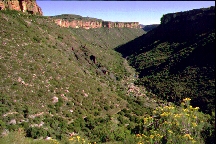  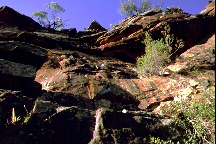  |
| Day three: Driefontein - Doltuin (12km) |
| Having found ourselves short of
drinking water, we chose to delay our breakfast until we had descended into the ravine
below. Thereafter, the strenuous ascent took us past a graveyard to the plateau on the
opposite side of the Oorlogskloof River, culminating in a tricky crawl with the assistance
of ropes through a natural chimney formed of rock. Though we had only been going for some
3/4 of an hour, we were already sweating profusely, the weather turning out to be somewhat
warmer than on the previous day, though there was a slight breeze. We remained on the
plateau for much of the walk, though Wessel had a few surprises in store for us. With each
breakfast, lunch and dinner our rucksacks ought to have been a wee bit lighter, though it
never seemed that way. An abundance of proteas was in evidence, along with aloe and the
rare elephant's foot plant. Fauna includes otter, dassies, duiker, klipspringer, steenbok,
grysbok, aardwolf, caracal, African wild cat and small stopped cat. Bat-eared and Cape
foxes and leopard have also been recorded. Spoor, fresh droppings and baboon carcasses
bear testimony to the movement of the latter through the area.
The route swung north and away from the gorge. We eventually entered a beautiful valley dense in fynbos, like some Garden of Eden, finally arriving at our next camp. A man-made catchment area provided us with water for drinking purposes as well as a much-needed swim. I awoke that night realising how inadequate my sleeping bag was proving to be. The tent was damp and made contact with my sleeping bag, which in turn was wet in places. I rearranged my position so as to align myself diagonally across the inside of my tent. I zipped up the tent flap more securely to prevent the cold from entering. In the morning I discovered why. A layer of ice had formed over the tent during the night. All in all, I'd had an entirely sleepless night, the vocal presence of wild donkeys in the vicinity not being of much help either! |
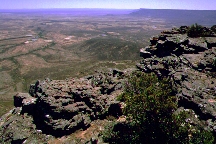 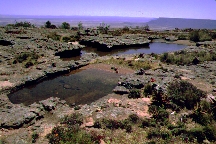   |
| Day four: Doltuin - Pramkoppie (17km) |
| Today would serve as the ultimate test of endurance. We left camp earlier than usual, heading off in a southwesterly direction towards the gorge in the Uitkomstvallei. Conversation on long straight sections on the plateau turned to the philosophical and the future of the human species. Perhaps the distance covered had begun to take its toll or perhaps my boots themselves were less than ideal because I had begun to develop blisters, while my toes were feeling somewhat tender. These were the same boots I'd used on my Kilimanjaro climb, where I'd experienced similar difficulties on the descent. Somewhere on this day, I, in a moment of delirium, was given to refer to Big Ron as 'Mike'. Big Ron's quick, dry wit came to the fore again, and for the rest of the trip I became 'Mike'. We paused for a welcome break at a rock that had been weathered to the extent that it formed a natural shelter with overhang, visible from afar. Wessel continued to lure us over boulders, sometimes with the assistance of ladders, to every cave, nook and cranny. Although it made sense not to undertake any hikes in this region in summer, as it is simply too hot, resulting in a probable shortage of drinking water, it struck us that we had unwittingly chosen the best time of the year to undertake the hike because the recent rains had also revealed to us such an enormous variety of fynbos vegetation that dominates the plateau region. Towards the late afternoon we were able to leave our rucksacks behind for a short 2.6 km detour to Arrie se Punt, which provided us with a splendid view from the edge of the escarpment, overlooking the R27 route and Van Rhyns Pass. Pools of water provided an indication of recent rains. Despite the increasing discomfort, the detour had been well worth it. Yet another troop of baboons voiced their displeasure in violation of their space! We hurried back to our rucksacks, lest we should fall victim to Wessels' practical jokes at the expense of the baboons searching for food. Following the edge of the escarpment in a northerly direction, we eventually descended its exterior, only to enter a valley that provided the approach to the final campsite of the hike. Just as in the case of the other camps, the approach was never direct and the camp hidden from view until one stumbled upon it at the last moment, another of Wessels' ploys. The beautiful campsite nestled under the trees near a small stream, with just enough water to fill the water bag and splash ourselves. This revitalised us after an exhausting day's walk. Pramkoppie literally means 'tit hill' in Afrikaans. One can only think that the poor trekker who probably named it had not laid eyes on a real one for some time, if he saw a resemblance in the hill at the mouth of the valley. |
| Day five: Pramkoppie - Groot Tuin (10.7km) |
| My feet were tender. If Wessels was amused, I certainly wasn't. A suggestion was made that by wearing my rock sandals with socks might make walking more bearable for the final leg of the journey. We left the valley where we had spent the night and ascended to the plateau. Uppermost in our minds was to complete the section and get the hell out of there, taking a short cut if possible. It wasn't a case of us not enjoying the walk but rather the psychological factor when one is acutely aware that the end is literally in sight. We seemed to meander across the plains, at times wondering whether we had lost our way. Gazing eastwards as the crow flies, Driefontein farm did not seem that far off, belying the distance we had covered the previous day. True to form, Wessel's taste for surprises was becoming all the more predictable, as he led us back into a valley of lush grass and reed, then up an ascent past yet another baboon troop's enclave, before finally reaching a junction encountered on the first day's walk. This led us back to the car park. Though the Swedish volleyball team had finally deserted us, our thoughts focussed on the cold beers that we had left in the vehicle. Encountering a group of hikers, bright-eyed and bushy-tailed though getting on in years, who passed us in a Toyota en route to leaving Oorlogskloof Nature Reserve and enquired as to how difficult the route was, Ralph presented a customary wry smile, though averting to blow the lid off the secret to......the scourge of Wessel. |
|
|